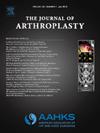基于磁共振成像分类预测创伤性股骨头坏死进展:一项回顾性队列研究。
IF 3.8
2区 医学
Q1 ORTHOPEDICS
引用次数: 0
摘要
背景:我们研究的目的是建立一种新的磁共振成像(MRI)分类系统来预测年轻人创伤性股骨头坏死(TONFH)的进展并评估其临床意义。方法:回顾性队列研究于2007年1月至2022年12月进行,包括134髋(134例患者,平均年龄41岁(范围21至43岁),65.7%男性)在协会研究循环骨(ARCO) i期诊断为TONFH。骨修复带(BRB)分类系统根据MRI冠状面将病变分为表面性(S型),不确定性(U型)和广泛性(E型)。对患者进行观察治疗和x线评估。随访期间观察影像学征象及股骨头塌陷情况。生存分析和Cox比例风险回归评估了BRB分类与疾病进展之间的关系。结果134例髋关节分为S型(n = 54)、U型(n = 21)和E型(n = 59)。在平均随访39.6个月,影像学标志是最普遍的E型(94.9%)和至少在S型(9.3%)、射线与中位时间18个月U型和16个月的迹象大肠型股骨头崩溃发生在50.8%的E型,U型23.8%,也没有在类型年代,34个月的平均时间崩溃大肠型单变量和多变量分析发现马上回来分类作为一个独立的疾病进展的预测,E型患者出现不良后果的风险最高。结论:新提出的BRB分类提供了评估TONFH坏死性病变严重程度的系统方法,并与股骨头塌陷风险有显著相关性。未来的研究需要进一步验证其临床意义,并探讨这种分类的解剖学基础。本文章由计算机程序翻译,如有差异,请以英文原文为准。
Predicting Progression of Traumatic Osteonecrosis of the Femoral Head Based on Magnetic Resonance Imaging Classification: A Retrospective Cohort Study
Background
The purpose of our study was to develop a novel magnetic resonance imaging classification system to predict the progression of traumatic osteonecrosis of the femoral head (TONFH) in young adults and assess its clinical implications.
Methods
A retrospective cohort study was conducted from January 2007 to December 2022, including 134 hips (134 patients, mean age 41 years (range, 21 to 43), 65.7% men) diagnosed with TONFH at Association Research Circulation Osseous Stage I. The bone repair band (BRB) classification system categorized lesions into Superficial (Type S), Uncertain (Type U), and Extensive (Type E) based on magnetic resonance imaging coronal views. Patients were followed with observational treatment and x-ray assessments. Radiographic signs and femoral head collapse were evaluated during follow-up. Survival analysis and Cox proportional hazards regression assessed the association between BRB classification and disease progression.
Results
The 134 hips were categorized into Type S (n = 54), Type U (n = 21), and Type E (n = 59). Over a mean follow-up of 39.6 months, radiographic signs were most prevalent in Type E (94.9%) and least in Type S (9.3%), with median times to radiographic signs of 18 months for Type U and 16 months for Type E. Femoral head collapse occurred in 50.8% of Type E, 23.8% of Type U, and none in Type S, with a median time to collapse of 34 months for Type E. Both univariate and multivariate analyses identified BRB classification as an independent predictor of disease progression, with Type E showing the highest risk for adverse outcomes.
Conclusions
The newly proposed BRB classification provides a systematic approach to assessing necrotic lesion severity in TONFH and demonstrates significant correlation with femoral head collapse risk. Future studies are needed to further validate its clinical significance and explore the anatomical basis underlying this classification.
求助全文
通过发布文献求助,成功后即可免费获取论文全文。
去求助
来源期刊

Journal of Arthroplasty
医学-整形外科
CiteScore
7.00
自引率
20.00%
发文量
734
审稿时长
48 days
期刊介绍:
The Journal of Arthroplasty brings together the clinical and scientific foundations for joint replacement. This peer-reviewed journal publishes original research and manuscripts of the highest quality from all areas relating to joint replacement or the treatment of its complications, including those dealing with clinical series and experience, prosthetic design, biomechanics, biomaterials, metallurgy, biologic response to arthroplasty materials in vivo and in vitro.
 求助内容:
求助内容: 应助结果提醒方式:
应助结果提醒方式:


